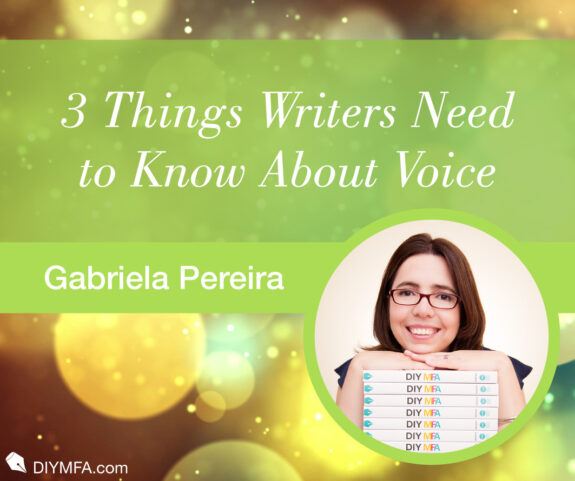The topic of voice has been on my mind a lot lately. It’s a subject that writers are expected to understand, but rarely does anyone actually explain what it really is. Until now.
Voice is the feel, the vibe, the sound, the essence of your writing. It’s that quality that makes your writing unmistakably yours. I think of it as being the literary equivalent of DNA. Everybody has it, and it manifests itself differently for each individual. It’s the thing that makes us unique.
When we talk about voice, there are a couple of important factors we need to keep in mind.
1) There is no such thing as “find your voice.”
A lot of writing teachers talk about needing to “find your voice” as if voice was loose change caught between the couch cushions. (“Hey look! I found a nickel!”) But the truth is, voice is something we already have. Our job isn’t to find it, but to hone it.
The problem I have with “find your voice” is that it implies that your voice is somehow missing and it’s up to you to find it again. This is a fallacy. You don’t need to find your voice because it never left in the first place. Just like Dorothy’s friends in The Wizard of Oz, you’ve had what you needed all along. You have a voice already, you just need to know how to use it.
Teachers often say “find your voice” when a student’s voice is clunky, stilted, or not yet polished. Really, this is a cop-out, because instead of trying to help the student hone their voice and make it better, the teacher throws their hands in the air and says, “You have no voice! Go out and find it.” This advice is completely unhelpful.
What is helpful is when a teacher shows the student how to hone their voice. This work might happen at the sentence level, where they study word choice, cadence, rhythm, and other techniques. Or it might also take place at the paragraph level, where they look at sentence structure and length, and consider how the meaning of a sentence is reflected in the style of the writing itself. The point is that voice isn’t something you find, it’s something you develop through persistent practice.
2) Honing your voice is all about modulation.
There is another danger with this “find your voice” attitude. It implies that our voice can be anything we want it to be. It’s as though we can find one voice, then find a different voice, and change from one to another as quickly as a supermodel changes outfits.
That is not the reality of voice. You see, your voice has a core essence that is the same no matter what you write. Just as you can’t grow roses from sunflower seeds, you can’t change your voice from one extreme to another. Instead, what you can do is modulate your voice, making subtle shifts rather than radical changes.
Let me give you an example. The voice I use when I give presentations (like webinars and workshops), is what I call “Professor Valley Girl.” It has a lot of punchy energy and is just a little bit silly, while still sharing an info-rich presentation and going deep into craft techniques. I used to use this same kind of voice in my newsletters, but over time, my newsletter voice has mellowed out a bit. It’s more relaxed, as though we were sitting across from each other, having a cup of coffee.
Am I a different person when I use “Professor Valley Girl” versus my coffee shop voice? No, of course not. I’m still me, which means my voice still has that same core essence. That said, there are subtle differences between those two different voices. This is what I mean when I talk about modulating voice: we can make small shifts in tone and style, but the core essence of the voice remains the same.
3) There are multiple layers of voice in narrative writing.
Pick up a piece of fiction or creative nonfiction and you will likely find that the voice has at least two layers. In fact, pieces of writing that have only one layer of voice are exceptionally rare. In general, the two layers that come into play in a piece of narrative writing are character voices and the narrator’s voice.
The voices of the characters most often come across in dialogue. Yes, you might also have the inner monologue of a first person narrator, but that is not the voice of the character. That’s the voice of the narrator—that narrator just happens also to be a character in the story. In fact, it is typical for the voice of a first person narrator to feel dramatically different from the character’s voice in dialogue.
Think of the Diary of a Wimpy Kid series. The diary part is the version of events that the main character wants us to believe happened, while the doodles show how things really went down. The humor comes across in the contrast between the two narrative threads. In this case, the author uses two different modes of language for the different layers of voice: verbal language for the diary narration and a visual language of doodles for many of the interactions between characters.
With the voices of our characters, we want to make sure they sound like distinct human beings and not feel like they are all the same person. A great example of this in action is the opening chapters of Pride and Prejudice, where we have multiple characters in a group scene, but each character sounds like a distinct person.
When it comes to narratorial voice, there are many artistic choices we as writers can make. Do we want the narrator to break the fourth wall and talk directly to the reader? Is the narrator opinionated and very in-your-face? Or is the narrator so subtle and invisible that we barely notice they are there? These effects don’t happen by accident. They are a conscious choice that a writer must make. The key is to make these choices intentional, rather than accidental.
Your voice will develop over time, but you need to put in the mileage—or the word count—to give your voice room to flourish and grow. In my previous article, How Writing Is Like Playing the Violin, I talked about the importance of practice in writing, and this is especially important when it comes to voice. In case you missed it, click here to read my article on practice.
Remember: you can’t grow roses from sunflower seeds, but with lots of sunshine and plenty of water you can grow some awesome sunflowers.
Until next time, keep writing and keep being awesome!

P.S. For more info on Gabriela Pereira, the founder and instigator of DIY MFA, check out her profile page.







